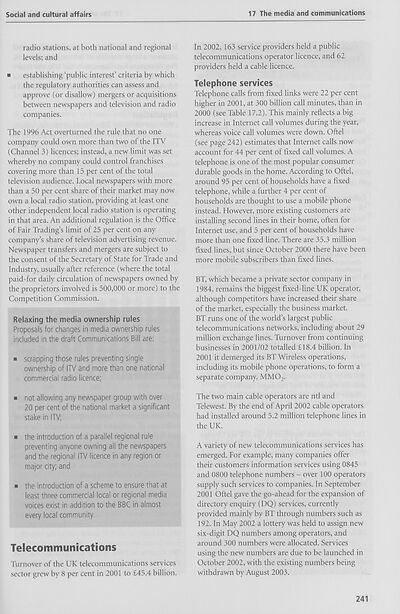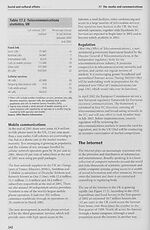Download files
Complete book:
Individual page:
Thumbnail gallery: Grid view | List view

Social and cultural affairs
17 The media and communications
radio stations, at both national and regional
levels; and
■ establishing ‘public interest’ criteria by which
the regulatory authorities can assess and
approve (or disallow) mergers or acquisitions
between newspapers and television and radio
companies.
The 1996 Act overturned the rule that no one
company could own more than two of the ITV
(Channel 3) licences; instead, a new limit was set
whereby no company could control franchises
covering more than 15 per cent of the total
television audience. Local newspapers with more
than a 50 per cent share of their market may now
own a local radio station, providing at least one
other independent local radio station is operating
in that area. An additional regulation is the Office
of Fair Trading’s limit of 25 per cent on any
company’s share of television advertising revenue.
Newspaper transfers and mergers are subject to
the consent of the Secretary of State for Trade and
Industry, usually after reference (where the total
paid-for daily circulation of newspapers owned by
the proprietors involved is 500,000 or more) to the
Competition Commission.
Relaxing the media ownership rules
Proposals for changes in media ownership rules
included in the draft Communications Bill are:
■ scrapping those rules preventing single
ownership of ITV and more than one national
commercial radio licence;
■ not allowing any newspaper group with over
20 per cent of the national market a significant
stake in ITV;
■ the introduction of a parallel regional rule
preventing anyone owning all the newspapers
and the regional ITV licence in any region or
major city; and
■ the introduction of a scheme to ensure that at
least three commercial local or regional media
voices exist in addition to the BBC in almost
every local community.
Telecommunications
Turnover of the UK telecommunications services
sector grew by 8 per cent in 2001 to £45.4 billion.
In 2002, 163 service providers held a public
telecommunications operator licence, and 62
providers held a cable licence.
Telephone services
Telephone calls from fixed links were 22 per cent
higher in 2001, at 300 billion call minutes, than in
2000 (see Table 17.2). This mainly reflects a big
increase in Internet call volumes during the year,
whereas voice call volumes were down. Oftel
(see page 242) estimates that Internet calls now
account for 44 per cent of fixed call volumes. A
telephone is one of the most popular consumer
durable goods in the home. According to Oftel,
around 95 per cent of households have a fixed
telephone, while a further 4 per cent of
households are thought to use a mobile phone
instead. However, more existing customers are
installing second lines in their home, often for
Internet use, and 5 per cent of households have
more than one fixed line. There are 35.3 million
fixed lines, but since October 2000 there have been
more mobile subscribers than fixed lines.
BT, which became a private sector company in
1984, remains the biggest fixed-line UK operator,
although competitors have increased their share
of the market, especially the business market.
BT runs one of the world’s largest public
telecommunications networks, including about 29
million exchange lines. Turnover from continuing
businesses in 2001/02 totalled £18.4 billion. In
2001 it demerged its BT Wireless operations,
including its mobile phone operations, to form a
separate company, MMO,.
The two main cable operators are ntl and
Telewest. By the end of April 2002 cable operators
had installed around 5.2 million telephone lines in
the UK.
A variety of new telecommunications services has
emerged. For example, many companies offer
their customers information services using 0845
and 0800 telephone numbers - over 100 operators
supply such services to companies. In September
2001 Oftel gave the go-ahead for the expansion of
directory enquiry (DQ) services, currently
provided mainly by BT through numbers such as
192. In May 2002 a lottery was held to assign new
six-digit DQ numbers among operators, and
around 300 numbers were allocated. Services
using the new numbers are due to be launched in
October 2002, with the existing numbers being
withdrawn by August 2003.
241
17 The media and communications
radio stations, at both national and regional
levels; and
■ establishing ‘public interest’ criteria by which
the regulatory authorities can assess and
approve (or disallow) mergers or acquisitions
between newspapers and television and radio
companies.
The 1996 Act overturned the rule that no one
company could own more than two of the ITV
(Channel 3) licences; instead, a new limit was set
whereby no company could control franchises
covering more than 15 per cent of the total
television audience. Local newspapers with more
than a 50 per cent share of their market may now
own a local radio station, providing at least one
other independent local radio station is operating
in that area. An additional regulation is the Office
of Fair Trading’s limit of 25 per cent on any
company’s share of television advertising revenue.
Newspaper transfers and mergers are subject to
the consent of the Secretary of State for Trade and
Industry, usually after reference (where the total
paid-for daily circulation of newspapers owned by
the proprietors involved is 500,000 or more) to the
Competition Commission.
Relaxing the media ownership rules
Proposals for changes in media ownership rules
included in the draft Communications Bill are:
■ scrapping those rules preventing single
ownership of ITV and more than one national
commercial radio licence;
■ not allowing any newspaper group with over
20 per cent of the national market a significant
stake in ITV;
■ the introduction of a parallel regional rule
preventing anyone owning all the newspapers
and the regional ITV licence in any region or
major city; and
■ the introduction of a scheme to ensure that at
least three commercial local or regional media
voices exist in addition to the BBC in almost
every local community.
Telecommunications
Turnover of the UK telecommunications services
sector grew by 8 per cent in 2001 to £45.4 billion.
In 2002, 163 service providers held a public
telecommunications operator licence, and 62
providers held a cable licence.
Telephone services
Telephone calls from fixed links were 22 per cent
higher in 2001, at 300 billion call minutes, than in
2000 (see Table 17.2). This mainly reflects a big
increase in Internet call volumes during the year,
whereas voice call volumes were down. Oftel
(see page 242) estimates that Internet calls now
account for 44 per cent of fixed call volumes. A
telephone is one of the most popular consumer
durable goods in the home. According to Oftel,
around 95 per cent of households have a fixed
telephone, while a further 4 per cent of
households are thought to use a mobile phone
instead. However, more existing customers are
installing second lines in their home, often for
Internet use, and 5 per cent of households have
more than one fixed line. There are 35.3 million
fixed lines, but since October 2000 there have been
more mobile subscribers than fixed lines.
BT, which became a private sector company in
1984, remains the biggest fixed-line UK operator,
although competitors have increased their share
of the market, especially the business market.
BT runs one of the world’s largest public
telecommunications networks, including about 29
million exchange lines. Turnover from continuing
businesses in 2001/02 totalled £18.4 billion. In
2001 it demerged its BT Wireless operations,
including its mobile phone operations, to form a
separate company, MMO,.
The two main cable operators are ntl and
Telewest. By the end of April 2002 cable operators
had installed around 5.2 million telephone lines in
the UK.
A variety of new telecommunications services has
emerged. For example, many companies offer
their customers information services using 0845
and 0800 telephone numbers - over 100 operators
supply such services to companies. In September
2001 Oftel gave the go-ahead for the expansion of
directory enquiry (DQ) services, currently
provided mainly by BT through numbers such as
192. In May 2002 a lottery was held to assign new
six-digit DQ numbers among operators, and
around 300 numbers were allocated. Services
using the new numbers are due to be launched in
October 2002, with the existing numbers being
withdrawn by August 2003.
241
Set display mode to:
![]() Universal Viewer |
Universal Viewer | ![]() Mirador |
Large image | Transcription
Mirador |
Large image | Transcription
The item on this page appears courtesy of Office for National Statistics and may be re-used under the Open Government Licence for Public Sector Information.
| Britain and UK handbooks > UK: The official yearbook of the United Kingdom of Great Britain and Northern Ireland > 2003 > (271) |
|---|
| Permanent URL | https://digital.nls.uk/204926633 |
|---|
| Attribution and copyright: |
|
|---|---|
| Description | Three volumes of 'UK: The official yearbook of the United Kingdom of Great Britain and Northern Ireland', published annually by the Office of National Statistics from 2002-2005. |
|---|---|
| Shelfmark | GII.11 SER |
| Description | Three titles produced by the British Government from 1954-2005 describing 'how Britain worked'. They are: 'Britain: An official handbook' (1954-1998), 'Britain: The official yearbook of the United Kingdom' (1999-2001), and 'UK: The official yearbook of the United Kingdom of Great Britain and Northern Ireland' (2002-2005). These 50 reports provide an overview of Britain's economic, social and cultural affairs, its environment, international relations, and the systems of government. They give an impartial summary of government policies and initiatives, and explain how public services are organised. |
|---|---|
| Additional NLS resources: |
|

